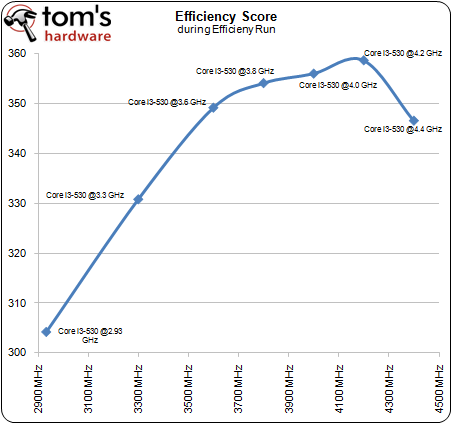Overclocking: Get The Performance Of A Core i5 From Core i3
Intel’s $115 Core i3-530 doesn't include Turbo Boost technology and it doesn't boast hardware-based AES-NI, but it overclocks like a fiend. We benchmarked this dual-core, HT-equipped chip at 4.4 GHz and determined the most power-efficient overclock.
Best Overclock And Conclusion

We purchased a retail Core i3-530 processor and used it on all of the overclocking tests detailed earlier. Slight voltage tweaks were unavoidable to ensure system stability at 3.8 GHz and up. The combination of Gigabyte’s P55A-UD7 and the Core i3-530 was amazingly stable at all times, except when we tried to cross the 4.5 GHz line. This was just too fast for this particular processor. A 4.2 or 4.4 GHz clock delivers vast performance improvements that set the Core i3-530 at performance levels beyond the Core i5-600-series and into performance levels typically reached by quad-core products.
As you can see in the diagram above, the Core i3-530 overclocked to 4.2 GHz delivers the highest power efficiency, expressed in performance per watt-hour. The score is a synthetic number resulting from the division of our performance results with the power consumption readings. Unfortunately, the 2.93 GHz stock speed delivers the worst power efficiency, so it makes a lot of sense to overclock the CPU at least a bit. This won’t jeopardize reliability or impact idle power, but it provides more horsepower to work on intensive workloads. This is the key to delivering great efficiency.
Going beyond 4.2 GHz requires significant voltage tweaks that negatively impact efficiency. You should only do this if you really know that the remaining speed upgrade delivers real benefits. In any case, a Core i5-750 quad-core might be the better investment for power users if budget allows. It results in similar system idle power and peak power at the same level as a Core i3 overclocked to 4.4 GHz. Then again, it’s important to mention that such a quad-core chip could still be overclocked on its own, yielding even more speed.
Get Tom's Hardware's best news and in-depth reviews, straight to your inbox.
Current page: Best Overclock And Conclusion
Prev Page Benchmark Results: Overall Efficiency